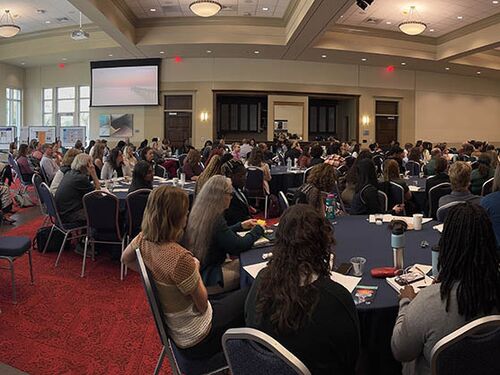Actions Needed by Higher Education Institutions, Technology Companies, Federal Agencies to Increase Representation of Women of Color in Tech
News Release
By Sara Frueh and Josh Blatt
Last update December 9, 2021
WASHINGTON — A range of organizations across the tech ecosystem — tech companies, colleges and universities, professional societies, and government agencies — should take steps to improve the representation of women of color in tech fields and careers, says a new report from the National Academies of Sciences, Engineering, and Medicine.
For example, tech companies should form a coalition with higher education institutions and professional societies to support women of color in tech and to promote effective recruitment and retention strategies. And federal agencies should incentivize grantee institutions’ efforts to improve diversity, equity, and inclusion through accountability measures.
In addition, tech companies should disaggregate employment data by race/ethnicity and gender and publicly share these data, the report says. Such data are needed to fully understand the employment landscape of the tech industry, measure progress in increasing representation of women of color, identify areas where additional resources are needed, and develop strategies for improving diversity, equity, and inclusion. Higher education institutions should collect and disaggregate quantitative and qualitative data on the recruitment and graduation experiences of students and the recruitment and promotion of faculty. And government efforts calling for data collection related to groups underrepresented in STEM and in tech should clearly indicate that such data be disaggregated by race/ethnicity and gender, to the extent possible given the need to protect anonymity of individuals.
“Persisting inequities such as opportunity gaps and the widening digital divide continue to reveal cracks in our society,” said Evelynn Hammonds, professor of African and African American studies and Barbara Gutmann Rosenkrantz Professor of the History of Science, Harvard University, and co-chair of the committee that wrote the report. “Failure to address these issues will cause a generation of talent to be lost as a result of not having access to tools that allow them to access pathways into tech and to thrive in tech disciplines.”
Women of color currently make up 39 percent of the female population in the United States and are projected to comprise the majority of women by 2060. However, in computing, women of color earn less than 10 percent of the bachelor’s degrees awarded and less than 5 percent of doctorates.
Women of color also remain underrepresented in the tech workforce, and the numbers of women from some racial and ethnic groups have even declined, the report notes. Black women hold 3 percent of jobs, Latinx women hold 1 percent, and Native American/Alaskan Native and Native Hawaiian/Pacific Islander women hold 0.3 percent. Women of color are underrepresented in tech leadership positions, as well.
Intersectional approach is needed, including data disaggregated by race
Many efforts to increase the number of women in tech have focused on women more broadly rather than address the specific contexts of women of color. To address the barriers that women of color face, the report stresses the need for an intersectional approach — one that recognizes the compounding nature of racial and gender discrimination.
Essential to taking an intersectional approach is disaggregating education and employment data by both race and gender — something often not done by education institutions and employers. The lack of data specific to women of color and subgroups of women of color has impeded efforts to fully understand the causes and consequences of underrepresentation and to develop effective ways to increase diversity, equity, and inclusion, the report says.
When policymakers, educators, and corporate leaders study issues related to women in tech, the term ‘women’ must reflect the experiences of all women.
“It is critically important to disaggregate data using an intersectional approach to develop effective strategies for increasing the success of women of color in tech and meet these challenges head on,” said committee co-chair Valerie Taylor, director of the Mathematics and Computer Science Division and Argonne Distinguished Fellow at Argonne National Laboratory, and CEO and president of CMD-IT. “When policymakers, educators, and corporate leaders study issues related to women in tech, the term ‘women’ must reflect the experiences of all women.”
Actions needed across tech ecosystem
Research evidence suggests that structural and social barriers in tech education, the tech workforce, and venture capital investment disproportionately and negatively affect women of color, the report says. It recommends actions to help overcome these barriers, such as:
Higher education leaders should widen recruitment efforts to identify women of color candidates to join their computer science, computer engineering, and other tech departments as students and faculty. Increased consideration should be given to those coming from two-year community colleges and minority-serving institutions. Higher education leaders should develop retention strategies focused on supporting these students and faculty during transitions to their institutions.
Companies and organizations working within the tech sector should create pathways for women of color into leadership positions and create positions for diversity, equity, and inclusion professionals that are part of executive leadership.
Tech companies should expand employment options that promote work-life balance such as remote work, flexible work hours, parental and other family leave, and career counseling as a strategy to improve retention and advancement and expand recruitment of women of color.
Industry and funding agencies should invest in expansion of certification and training programs for women of color that are delivered by community-based organizations to scale their capacity to recruit and prepare a greater number of women of color in tech. These investments should expand opportunities for apprenticeships and people seeking to enter or reenter the tech workforce.
Professional societies should create programs and/or initiatives directed at developing additional pathways that advance women of color in tech. These programs should have a strong evaluation component to demonstrate impact and provide recommendations for scaling successful models. Programming should include certification and badging options defined collaboratively with, and recognized by, industry and academic partners. Moreover, professional societies should be intentional about diversifying their internal leadership.
To promote transparency and accountability, Congress should amend section 709e of the Civil Rights Act of 1964 to require public release of EEO-1 workforce demographic data by companies, which would include those that are the recipients of government contracts supported by taxpayer dollars.
In addition, more research, and more funding for research, should be dedicated to significantly expanding the knowledge base about how to better support and retain girls and women of color in technology and computing education and careers, the report says. It identifies over a dozen priority topics for research — for example, differences between girls of color and non-Hispanic white girls with regard to the digital divide and access to computer science courses; how finances and financial aid in higher education impact entry into and persistence in tech and related fields for women of color; and effective workplace recruitment and hiring of women of color in tech and related fields.
The study — undertaken by the Committee on Addressing the Underrepresentation of Women of Color in Tech — was sponsored by the National Science Foundation and the National Institute of Standards and Technology. The National Academies of Sciences, Engineering, and Medicine are private, nonprofit institutions that provide independent, objective analysis and advice to the nation to solve complex problems and inform public policy decisions related to science, technology, and medicine. They operate under an 1863 congressional charter to the National Academy of Sciences, signed by President Lincoln.
Contacts:
Sara Frueh, Senior Media Officer
Josh Blatt, Media Associate
Office of News and Public Information
202-334-2138; e-mail news@nas.edu
Featured Publication
Consensus
·2022
Demand for tech professionals is expected to increase substantially over the next decade, and increasing the number of women of color in tech will be critical to building and maintaining a competitive workforce. Despite years of efforts to increase the diversity of the tech workforce, women of color...
View details


